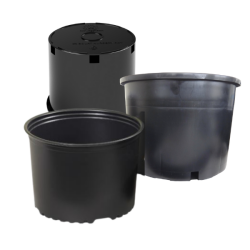Wholesale Plastic Nursery Pots & Plant Pots
Nursery growers start seeds, root cuttings, grow seedlings, transplant trees, shrubs, and flowers, and cultivate a crop that their buyers need. You see these neatly arranged in grids of potted plants that develop into the landscaping material for homes, national parks, environmental restoration areas, and so much more—all these plants in plastic pots. Yet, plastic nursery pots are not all the same.
Thermoformed Plastic Nursery Pots- 3D printed, mostly from recycled materials. These plastic plant pots feature a smooth outer texture and come in many sizes including #5 or #8, which refers to the angle of the pot's side. A #5 pot has more room for roots, thanks to its broader base. The #8 pot has a tapered side that makes its base narrower than the #5 pot. Most plastic plant pots feature a durable lip and raised footing for better drainage. There are many other #sizes to fit the needs of the plastic plant pots wholesale industry.
Blow Molded Plastic Nursery Pots – plastic plant pots created through blow mold fabrication are often inexpensive, and the process is relatively rapid. The plastic plant pots may be constructed of recycled plastic or not, though there is much pressure on the industry to find sustainable polymers. Blow mold plant pots are often ribbed, thin, but durable. They offer an inexpensive way for nurseries to plant thousands of plants without the considerable cost that other pot types may carry.
Injection Molded Plastic Nursery Pots - A long-used method of creating repetitive plastic parts. Injection molding is part of almost every industry. For the nursery industry, injection mold plant pots are liquid plastic that is forced into a mold and then rapidly cooled. The process is very efficient and automated, making the end product affordable. The material may be a single type of plastic or a mixture of plastics, even plastics that are stronger than steel.
Air Root Pruning Plastic Plant Pots - Many growers are upgrading to plastic air pruning pots from the standard solid wall plastic nursery pots. Depending on the design, plastic air pruning pots will utilize any of the above methods of production but include various shaped holes in the outer wall of the pot to allow for root tips to pass through. Once meeting air on the outside, the tip will die causing the plant to immediately produce a secondary root thus making the root structure much more complex and robust.
Alternatively, many growers are turning to fabric grow bags for improved plant root development through root entrapment.
Automation-Friendly Nursery Containers
Looked upon as a solution to a labor shortage and rising costs, automating the propagation process can lead to an efficient and profitable operation. While it is the least mechanical and least complex of the whole automation process, it is important to remember that not all planting containers (trays or pots) are created equal. Some can even create more problems than they solve. There are 3 things to keep in mind when sourcing automation-friendly plant pots:- Defined Rim - most automation equipment has 'fingers' that need to grab the container from a stack of pots. There needs to be a defined rim (square or round) and plenty of space between the rim of each container allowing the equipment de-stack one pot at a time - not multiples.
- Sturdy Sidewall Construction - automation equipment can be forceful. If the walls of the pot are too thin, they will crush under the pressure of certain automated machines or become repeatedly jammed in the machine.
- Thermoformed - causes de-nesting challenges, but works well with fork systems IF the rims protrude sufficiently.
- Blow-Molded - poor choice all the way around. The thin material will cause de-nesting issues while the absence of a pronounced rim prevents them from being used with fork systems.
- Injection Molded - best option for all automated equipment
- Container Base Construction - new 'suction' technology is replacing the 'finger' grab of stacked containers. If your automation equipment is using the new suction technology, you want to make certain the bottom center of your pot is completely flat.


